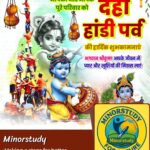Happy Krishna Janmashtami: History, Facts, Significance, and Its Impact on Life
Happy Krishna Janmashtami, also known as Krishna Jayanti, is one of the most cherished Hindu festivals, celebrating the birth of Lord Krishna, the eighth avatar of Lord Vishnu. Observed annually on the Ashtami (8th day) of Krishna Paksha (dark fortnight) in the month of Bhadrapada, this festival typically falls in August or September. Across India and around the world, devotees mark the occasion with joy, devotion, and cultural celebrations.
History of Happy Krishna Janmashtami
The festival has deep roots in Hindu mythology. Lord Krishna was born to Devaki and Vasudeva in a prison in Mathura. His birth was destined to end the tyrannical rule of King Kansa, who feared a prophecy that Devaki’s eighth child would kill him. Krishna was secretly transported to Gokul and raised by foster parents Yashoda and Nanda.
Janmashtami celebrates Krishna’s divine birth and his leelas (playful pastimes), reflecting his teachings on dharma, devotion, courage, and love. These stories inspire millions, making the festival a blend of spiritual reflection, moral lessons, and joyous celebration.
Fun and Interesting Facts About Happy Krishna Janmashtami
Midnight Birth: Lord Krishna is believed to have been born at midnight, which is why devotees perform special midnight celebrations and prayers.
Fasting Tradition: Many observe a day-long fast, breaking it after midnight rituals. This fasting is seen as a form of devotion and spiritual discipline.
Dahi Handi Festival: In Maharashtra, young men form human pyramids to break a pot of butter, replicating Krishna’s playful childhood activity of stealing butter.
Temples and Pilgrimages: Major celebrations take place at Mathura, Vrindavan, Dwarka, and Udupi Krishna Temple, attracting thousands of devotees.
Global Celebrations: Beyond India, Janmashtami is celebrated in Nepal, Mauritius, Fiji, Trinidad & Tobago, and by Indian diaspora communities worldwide.
Krishna’s Teachings: His life and teachings in the Bhagavad Gita inspire moral, ethical, and spiritual growth in devotees.
Raslila Performances: Classical dance-dramas depicting Krishna’s youthful exploits are staged in many temples and cultural centers.
Home Decorations: Devotees decorate homes with flowers, lights, and miniature cradles, symbolizing Krishna’s birth.
Timeline of Krishna Janmashtami
Ancient Period: Worship of Krishna dates back thousands of years through Vedic texts and Puranas.
Medieval Period: Saints like Meera Bai, Surdas, and Chaitanya Mahaprabhu popularized Krishna devotion through poetry, bhajans, and spiritual discourses.
Modern Period: Public celebrations with Dahi Handi, Raslila, and bhajan gatherings became widespread in India.
21st Century: Global celebrations, social media awareness, and eco-friendly practices now enrich Janmashtami festivities worldwide.
FAQs About Happy Krishna Janmashtami
Q1: When is Krishna Janmashtami celebrated?
A: It is observed on Ashtami of Krishna Paksha in Bhadrapada, usually falling in August or September.
Q2: What is Dahi Handi?
A: Dahi Handi is a festival tradition in Maharashtra, recreating Krishna’s playful act of stealing butter by forming human pyramids to break a pot.
Q3: What are the main rituals of Janmashtami?
A: Devotees fast, sing bhajans, perform Raslila, decorate temples and homes, and break Dahi Handi (in some regions).
Q4: Is fasting mandatory?
A: Fasting is traditional but can vary according to individual practices and family customs.
Q5: How is Krishna worshiped during Janmashtami?
A: Devotees offer flowers, fruits, sweets, and recite prayers, mantras, and verses from the Bhagavad Gita.
Significance of Happy Krishna Janmashtami
Spiritual Significance: Celebrating Krishna’s birth reminds devotees of his teachings and the importance of devotion, dharma, and love.
Moral Lessons: Krishna’s life stories teach courage, compassion, cleverness, and righteousness.
Cultural Importance: Raslila, bhajans, and folk dances preserve classical arts and traditions.
Community Bonding: Festivals like Dahi Handi promote teamwork, cooperation, and social harmony.
Inspiration for Youth: Stories of Krishna encourage children to develop virtues like honesty, creativity, and devotion.
Observance and Celebration
Fasting and Vigil: Devotees fast until midnight, breaking it with prayers and sweets.
Temple Decorations: Temples and homes are adorned with lights, flowers, and miniature cradles symbolizing Krishna’s birth.
Raslila and Bhajans: Performances depicting Krishna’s divine pastimes are organized for public enjoyment.
Dahi Handi Events: Community celebrations, especially in Maharashtra, highlight fun, teamwork, and devotion.
International Celebrations: Temples globally organize bhajan sessions, cultural programs, and educational events about Krishna’s teachings.
Daily Life Impact
Promotes Discipline: Fasting and rituals cultivate patience and self-control.
Strengthens Community: Public celebrations foster cooperation and bonding among participants.
Cultural Engagement: Children and adults participate in arts, storytelling, and devotional activities, preserving cultural heritage.
Spiritual Growth: Provides inner peace and moral reflection, influencing daily behavior positively.
Values Education: Krishna’s stories instill ethical, moral, and spiritual values in individuals.
Wishing Ideas
“Wishing you a joyful and blessed Happy Krishna Janmashtami filled with devotion and happiness!”
“May Lord Krishna inspire your life with wisdom, courage, and love. Happy Janmashtami!”
“Celebrate Krishna’s birth with devotion, joy, and togetherness. Happy Krishna Janmashtami!”
Key Points to Remember
Happy Krishna Janmashtami celebrates the divine birth of Lord Krishna.
Rituals include fasting, prayers, bhajans, Raslila, and Dahi Handi celebrations.
The festival emphasizes spiritual growth, moral values, cultural heritage, and social bonding.
Krishna’s teachings encourage courage, devotion, and righteousness, enriching daily life.
Conclusion
Happy Krishna Janmashtami is not just a festival; it is a celebration of devotion, morality, and cultural heritage. Observing Janmashtami connects devotees with the timeless wisdom of Lord Krishna, inspiring spiritual growth, ethical conduct, and social harmony. The festival’s joyous rituals, fasting, bhajans, and cultural performances offer a perfect blend of spiritual reflection and communal celebration, making it an event that touches hearts and minds worldwide.
Through Janmashtami, society strengthens its cultural identity, moral values, and devotion, ensuring that Krishna’s teachings continue to guide generations in leading a life of love, wisdom, and righteousness.
Daily Life Impacts:
Encourages discipline, patience, and devotion.
Strengthens community engagement and cultural preservation.
Promotes moral and spiritual education for children and adults alike.
Significance to Society:
Preserves Indian cultural and spiritual heritage.
Inspires ethical behavior, social harmony, and communal unity.
Encourages spiritual growth and moral reflection among devotees worldwide.








